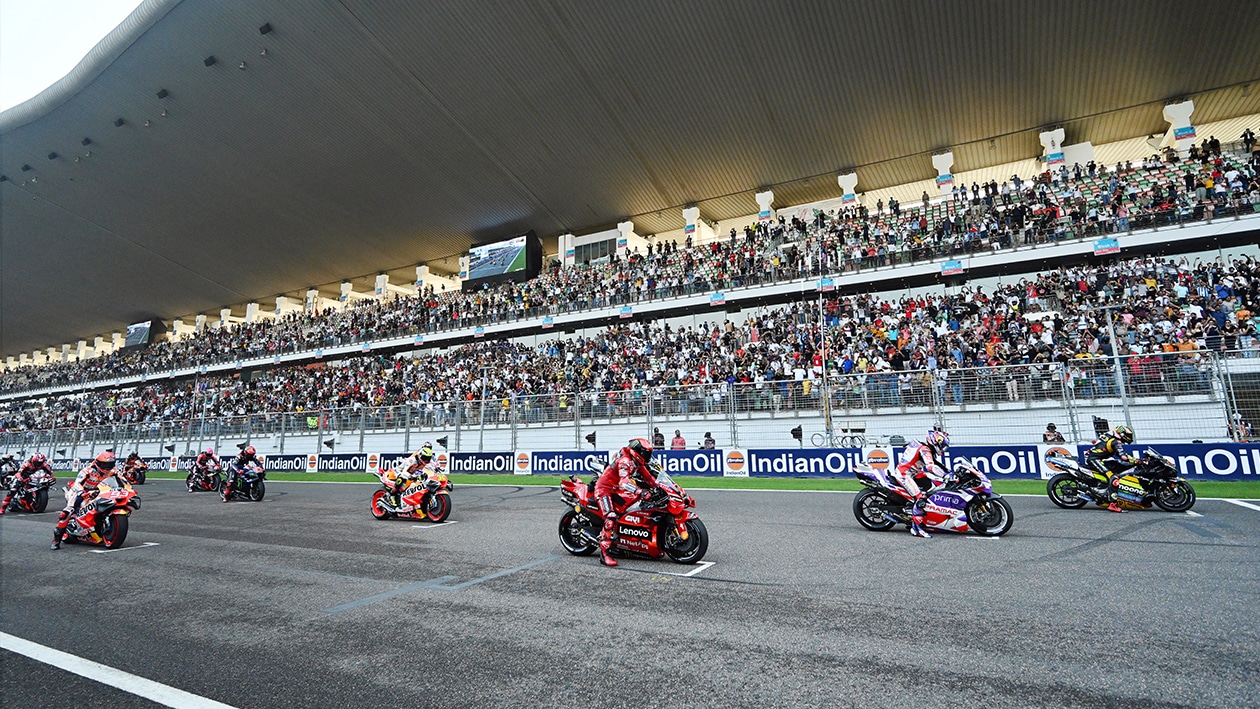Mat Oxley: Is Indian GP just the start for world’s biggest motorcycle maker & MotoGP?
“So will an Indian manufacturer ever contest MotoGP? Why not?”

Riders line up for Indian GP sprint race
Ajay Aggarwal/Hindustan Times via Getty
Something significant happened in the world of motorcycling this year: India overtook China as the world’s leading manufacturer of powered two-wheelers, with an annual output of more than 18 million units.
That’s a lot of motorcycles and scooters, but there are many more powered two-wheelers on the roads of India – around 160 million. The country moves and grooves on two wheels, with riders ducking and diving through the traffic, which seems to flow like a single river running in several different directions. It’s a joy to watch: a remarkable motion of beautiful chaos.
A dozen Indian brands now manufacturer motorcycles, generating profits that have inevitably led some to motor sport. The country’s biggest brand, Hero MotoCorp, contested the 2023 Dakar with its own motorcycle, winning two stages, so these are no longer what some Westerners once mocked as second-class outfits.
By chance, India marked its crowning as the world’s greatest motorcycling power by hosting its first MotoGP round in September, in the 75th year of the world championship. The event was staged at the Buddh Circuit, where Formula 1 raced from 2011 to 2013.
Serious doubts hung over the race until it actually happened. The Hermann Tilke-designed track works brilliantly for bikes and the crowd was keen and knowledgeable. The only real issue was the furnace-like heat.
Several teams ran temperature sensors in their cockpits (where riders tuck in behind the screen) and inside riders’ boots, which revealed riders were breathing air at over 50°C, while their feet were slow-cooking at 60. No matter, the event was judged a great success, so Buddh will host MotoGP until at least 2029.
“Sensors revealed riders were breathing air at over 50C”
India’s motorcycle story began soon after independence in 1947, when Jawaharlal Nehru’s government decided its army and police needed machines. Almost a thousand 350cc Royal Enfield Bullets – manufactured in Redditch, Worcestershire – were imported. Soon, only the parts were imported, the machines assembled in Chennai (then Madras) by the newly formed Enfield of India, an Anglo-Indian partnership that perhaps signified the changing of the guard.
During the 1960s, as the British motorcycle industry collapsed under the weight of Japanese competition, Royal Enfield sold all its Bullet machine tools and jigs to Enfield of India.
For several decades Indian roads were ruled by mongrel Anglo-Indian machines, mostly Bullets and Morris Oxford cars. Like Enfield, Morris Motors of Cowley had sold the tooling for its Oxford saloon to the Indians, who rechristened it the Hindustan Ambassador. Even now, you see a few loping around Delhi, like sweet old gentlemen making their way through the morass of modern humanity.
Liberalisation of Indian industry in the 1980s changed everything. Four brothers of the Munjal family, who had fled the vicious partition of India and Pakistan in the late 1940s, went into business with Honda, building small-capacity, low-cost bikes in Hero Honda’s first factory near Delhi.
This was an unbeatable partnership, between the world’s biggest motorcycle manufacturer and one of the world’s fastest-growing markets. You might think Honda was the senior partner, but a decade or so ago the Mujal family exited the agreement and now Hero MotoCorp sells nearly half the powered two-wheelers in India, around eight million units. Second in the sales league comes Honda itself.
What’s really interesting is how legendary brands have bent themselves to get in on the act. Until recently, Harley-Davidson only sold large-capacity V-twins. Few Indians can afford such machines, so Harley did a deal with Hero MotoCorp to produce the X440, a 440cc single, manufactured in Rajasthan, northern India.
Austrian brand KTM, Europe’s largest motorcycle manufacturer and a major player in MotoGP, has even stronger links with India. The company is 49% owned by Bajaj Auto, India’s second-biggest motorcycle maker, based in Pune, near Mumbai. Bajaj makes motorcycles for itself, for KTM and now for Triumph. The Leicestershire-based marque, brought back to life in the 1990s by construction magnate John Bloor, produces a variety of highly regarded larger-capacity motorcycles. Its total annual output was around 84,000 units. Earlier this year Triumph launched a new 400cc single, aimed solely at the Indian market. Bajaj will annually make 100,000 of these machines, thereby more than doubling Triumph’s global output in one fell swoop.
Meanwhile India’s third-largest producer, TVS Motor Company, recently bought Norton and has invested £100m in a new Norton factory in Birmingham, where the brand originated in 1902.
BSA, also born in the city as the Birmingham Small Arms Company, is also rising again via Indian investment. The vast Mumbai-based Mahindra group relaunched the iconic Gold Star last year. Production of the machine is due to move from India to Birmingham. The numbers and ambition make you swoon.
So will an Indian manufacturer ever contest MotoGP? Why not? Mahindra entered Moto3 (MotoGP’s Formula 3) in 2011, when the company chairman announced, “The Indians are coming!” Mahindra won two GPs before quitting the class a few years later. The premier category is within reach for whichever Indian manufacturer is ready to commit.
Mat Oxley has covered motorcycle racing for many years – and also has the distinction of being an Isle of Man TT winner
Follow Mat on Twitter @matoxley

